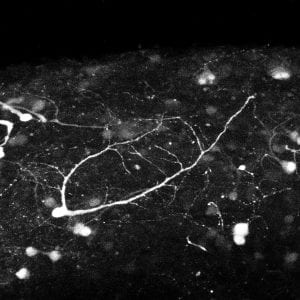
Lab-grown 6-month-old human Purkinje cell (Image by Alexander Atamian and Marcella Birtele/Quadrato Lab)In a first for USC Stem Cell scientists, the laboratory of Giorgia Quadrato, an assistant professor of stem cell biology and regenerative medicine, has pioneered a novel human brain organoid model that generates all the major cell types of the cerebellum, a hindbrain region predominantly made up of two cell types necessary for movement, cognition, and emotion: granule cells and Purkinje neurons. This marks the first time that scientists have succeeded in growing Purkinje cells that possess the molecular and electrophysiological features of functional neurons in an all-human system. These breakthroughs in organoid-directed brain modeling have been published recently in the journal Cell Stem Cell.
“The reproducible co-development and maturation of the main cell types of the developing cerebellum in a human organoid model provide a new way to explore the underlying biology of cerebellar development and disorders and advance therapeutic interventions,” explained Quadrato, an assistant professor in the Eli and Edythe Broad CIRM Center for Regenerative Medicine and Stem Cell Research at the Keck School of Medicine of USC.
To read more, visit https://stemcell.keck.usc.edu/scientists-develop-organoids-to-study-human-cerebellar-development-and-disease.